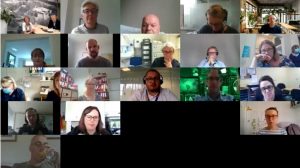Sharing good practice: Improving patient flow with Iain Roberts, Head of Programmes
Soon after we went into UK lockdown in March I started to feel rough. I was tired, irritable, and was suffering from dreadful headaches. It was a few days before I realised that I was missing my daily Starbucks. It didn’t take too much time for me to adjust to having less caffeine and I was able to get my hands on small tins of Starbucks Espresso to see me through.
I couldn’t have been happier when lockdown eased and the drive-thru Starbucks opened. However, I have noticed that I am extremely intolerant of my fellow coffee drinkers in the queue.
The first irritation are the cars that take ages to give their order. The second is that when they pull forward to collection, they don’t move fully, so that I can’t quite get close enough to place my order. The last irritation is that people seem to take them ages to place the coffee in their car and they fiddle about for what seems ages before they pull off.
My daughter and I have a neat system, which we think is more considerate to the driver behind. When we get our drinks, I automatically move my car forward, so that the next car can get to the window to pay and receive their drinks. This little drive forward allows us put our drinks safely in the cup holders, and we think it speeds the queue up – a little bit.
At this point you must be thinking what a small minded person I am, but I am curious about the flow of a queue! What hold’s it up, and whether people realise that the way they behave might delay others. The flow of the queue has been a big part of my career. I was reminded of my time at Gloucestershire Royal Hospital in the early 1990s where I was bed manager. My colleagues in Accident and Emergency were always keen to know if a bed was free for a waiting patient. That was the easy bit, however, what they always wanted to know was, is the bed free now? They would often phone a ward to say that they were coming up with a patient now and to get the bed ready.
What was clear was that those few minutes on the ward to get the discharge right, were just as important to A&E. Making a space in A&E was crucial to their ability to respond to the next ambulance arriving at the front doors.

On 23 September Improvement Cymru hosted an online session with colleagues from Holland to talk about patient flow in hospital. If you weren’t able to join the meeting there is a recording of the session to accompany this blog.
The session described three things. Firstly, the importance of improving flow in hours – so when a bed is available and how quickly can we fill it. Secondly, reducing length of stay in days and thirdly, working to safely keep more patients at home.
During this event, where 70 people joined the conversation, we learned about the methodology of ‘Real Time Demand Capacity’, which colleagues in the Netherlands have implemented. Improvement Cymru is keen to support the service on patient flow. There is a science to flow and we are keen to help explain and teach it.
It is our aim in 2021 to help improve the understanding of the science of flow using lean and to support implement these principles into our health and social care systems. We think that this will have a significant impact on this problem.
The majority of Improvement Cymru is currently focussed on supporting Public Health Wales NHS Trust, with it’s response to COVID19 – and now more than ever with the additional consideration of having to socially distance patients we’re keen to help with capacity to support and sustain improvement work on flow. Early work is underway to explore whether the work from the Netherlands can be tested in Wales.
So what is the Improvement Cymru offer of support on flow at the moment?
Firstly, please listen to the session. If you are interested in the discussion, then please share it with your colleagues in your health system. We are happy to introduce you to our colleagues in Holland.
Secondly, if you want to learn more about flow or RTDC to help you to prepare for this winter, then please do contact Improvement Cymru to see how this might be applied to your own local planning. RTDC has a hospital focus however, our offer also includes supporting the implementation of lean principles across the social and health care pathways and so also includes community services
The more you become attuned to the science of flow there become lots of questions to ask. I am sure you could re-design and improve the flow where you work. If you knew today who was likely to go home tomorrow, what would the hospital need to do to be able to make that happen? We would love to learn about this with you and to help.
So what is my theory about the delay in the queue at the Starbucks drive thru? For me it would be:
- The people who want cooked sandwiches take the longest
- Fancy frappucinos and the number ordered come next
- The indecisive or new shopper who doesn’t know what to do
- Too few baristas or someone learning the job
- No one in the queue thinking about anyone else – is there space for the car behind to order.
Having now written this, perhaps I need to re-think my relationship with coffee…..
For more information please contact:
Iain Roberts, Head of Programmes
Rebecca Hanmer, Senior Improvement Manager
Adam Didcott, Senior Improvement Manager
